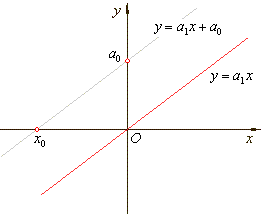|
|
|
|
|
|
|
| The
graphs
of algebraic
and transcendental functions |
| Elementary
functions are, Algebraic functions
and Transcendental functions |
| Algebraic
functions |
|
· The
polynomial function
f (x) =
y = anxn
+ an-1xn-1
+ an-2xn-2
+
.
. . +
a2x2
+
a1x + a0 |
|
y
=
a1x
+ a0
- Linear
function |
|
y
=
a2x2
+
a1x + a0
-
Quadratic
function |
|
y
=
a3x3
+
a2x2
+
a1x + a0
-
Cubic
function |
|
y
=
a4x4
+
a3x3
+
a2x2
+
a1x + a0
-
Quartic
function |
|
y
=
a5x5
+ a4x4
+
a3x3
+
a2x2
+
a1x + a0
-
Quintic
function |
|
- - - -
- - - - - - - - -
- - - - - - - -
- - - - - - - - |
| ·
Rational
functions - a ratio of two polynomials |
 |
|
-
Reciprocal function |
 |
| |
-
Translation of the reciprocal function,
called linear rational function. |
 |
|
|
| The
graphs of the
polynomial functions |
| The
graph of a function ƒ
is drawing on the Cartesian plane, plotted with respect to
coordinate axes, that shows functional relationship between
variables. The points (x,
ƒ (x)) lying on the curve
satisfy this relation. |
|
| The
source
or original polynomial function |
| Any
polynomial f (x)
of degree n >
1 in the general form, consisting
of n
+ 1 terms, shown graphically, represents translation of its
source (original) function in the direction of the coordinate
axes. |
|
The source polynomial function |
|
fs
(x)
= an
xn
+ an-2
xn-2
+
.
. . +
a2
x2
+ a1
x
|
|
|
| has
n
- 1 terms
lacking second and the constant term, since its coefficients, an-1
=
0
and a0
=
0
while
the leading coefficient an,
remains unchanged. |
| Therefore,
the source polynomial function passes through the
origin. |
| A
coefficient ai
of
the source function is expressed by the coefficients of the general
form. |
|
| Translating
(parallel shifting) of the polynomial function |
| Thus,
to obtain the graph of a given polynomial function f
(x)
we translate (parallel shift)
the
graph of its source function in the direction of the x-axis
by x0
and in the direction of the y-axis
by y0. |
| Inversely,
to put a given graph of the polynomial function beck to the
origin, we translate it in the opposite direction, by taking the
values of the
coordinates of translations with opposite sign. |
|
| Coordinates of translations
and their role in the polynomial expression |
| The
coordinates of translations we calculate using the formulas, |

|
| Hence,
by plugging the coordinates of translations into
the source polynomial function fs
(x),
i.e., |
|
y
- y0
= an(x
- x0)n
+ an-2(x
- x0)n-2
+
.
. .
+
a2(x
- x0)2
+ a1(x
- x0) |
|
|
| and
by expanding above expression we get the polynomial function in
the general form |
| f(x) =
y = anxn
+ an-1xn-1
+ an-2xn-2
+
.
. . +
a2x2
+
a1x + a0. |
| Inversely, by plugging the coordinates of translations into
the given polynomial f
(x)
expressed in the general form,
i.e., |
|
y
+ y0
= an(x
+ x0)n
+ an-1(x
+ x0)n-1
+
.
. .
+ a1(x
+ x0)
+ a0 |
|
|
| and
after expanding and reducing above expression we get its source polynomial function. |
| Note
that in the above expression the signs of
the coordinates of translations are already changed. |
|
| Linear
function y
= a1x
+ a0 |
| y
= a1x
+ a0
or y
= a1(x
-
x0)
or y
-
y0
= a1x, |
| where
x0
=
-
a0/a1
and/or y0
= a0. |
| By
setting x0
= 0 or y0
= 0
obtained is |
| the
source linear function
y
= a1x. |
|
|
 |
|
|